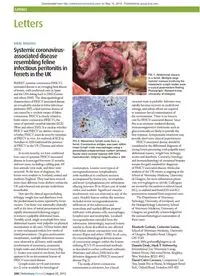
2012 Systemic coronavirus-associated disease resembling feline infectious peritonitis in ferrets in the UK PDF
Preview 2012 Systemic coronavirus-associated disease resembling feline infectious peritonitis in ferrets in the UK
200 | Veterinary Record | August 25, 2012 Letters Letters Letters VIRAL DISEASES Systemic coronavirus- associated disease resembling feline infectious peritonitis in ferrets in the UK Ferret systemic coronavirus (FrSCV)- associated disease is an emerging fatal disease of ferrets, with confirmed cases in Spain and the USA dating back to 2002 (Garner and others 2008). the clinicopathological characteristics of FrSCV-associated disease are remarkably similar to feline infectious peritonitis (FIP), a fatal systemic disease of cats caused by a virulent variant of feline coronavirus. FrSCV is closely related to ferret enteric coronavirus (FreCV), the cause of epizootic catarrhal enteritis (eCe) (Wise and others 2010). It is unclear whether FrSCV and FreCV are distinct viruses or whether FrSCV arises de novo by mutation of FreCV in vivo. An outbreak of eCe in Yorkshire in 2010 confirmed the presence of FreCV in the UK (thomas and others 2012). In recent months, we have confirmed four cases of systemic FrSCV-associated disease in ferrets aged between 10 months and two years, including a sibling pair. All four animals were male, and three were neutered. At the time of diagnosis, the ferrets were resident in Scotland, central and southern england. they had been sourced from three different ferret shelters within the UK and rehomed into private multi-ferret households. Non-specific clinical signs including lethargy, weight loss and diarrhoea were the predominant features reported by ferret owners. One ferret was reportedly clinically well at the time of initial presentation but rapidly deteriorated following surgery to remove a palpable abdominal mass. Variably sized, single or multiple firm intra- abdominal masses were palpable on physical examination in all cases. All four ferrets died or were euthanased within five weeks of initial presentation. On gross postmortem examination, multiple abdominal masses were observed in all ferrets with variable involvement of mesentery, mesenteric lymph nodes and abdominal viscera (Fig 1). Ascites was noted in one ferret, but this appears to be an inconsistent feature of FrSCV-associated disease. Lymph nodes (n=4) and intestine (n=2) were available for histological examination. Lesions were typical of necrogranulomatous lymphadenitis with multifocal to confluent necrosis accompanied by histiocytic, neutrophilic and lesser lymphoplasmacytic infiltration effacing between 30 to 90 per cent of nodal cortex and medulla. Significant vascular involvement was not observed in any of the cases. Notable lesions within the intestine included severe necrogranulomatous infiltration of the submucosa and muscularis and marked diffuse proprial infiltrates with plasma cells, macrophages, lymphocytes and neutrophils. Localised necrogranulomas extended from the submucosa. Interestingly, mucosal lesions similar to those described in cats affected with feline enteric coronavirus were also present (Kipar and others 1998). In all cases, the immunohistological demonstration of coronavirus antigen within the lesions utilising FCV3-70 monoclonal antibody as described in earlier confirmed outbreaks (Martinez and others 2008) led to the definitive diagnosis of FrSCV-associated disease (Fig 2). the mode of ferret coronavirus transmission is unknown, but a faecal- oronasal route is probable. Infection may rapidly become enzootic in multi-ferret settings, and robust efforts are required to minimise faecal contamination of the environment. there is no known cure for FrSCV-associated disease. Since this is an immune-mediated disease, immunosuppressive treatments such as glucocorticoids are likely to provide the best response. Symptomatic treatment may provide short-term clinical improvement. FrSCV-associated disease should be considered in the differential diagnosis of young ferrets presenting with palpable intra- abdominal masses, weight loss, lethargy, ascites and diarrhoea. Currently, histology and immunohistology of excisional biopsies remain the gold standard for diagnosis of FrSCV-associated disease. Molecular analysis of the UK viruses is ongoing at the School of Veterinary Medicine, University of Glasgow; for more information please visit www.glasgow.ac.uk/vds. Colleagues are invited by the authors to submit faecal (eG), or unfixed and fixed (DD and eG) postmortem material from suspected cases. the Department of Veterinary Pathology, University of Liverpool, and the Histopathology Laboratory, School of Veterinary Medicine, University of Glasgow, are gratefully acknowledged for the immunohistological examination of these cases. Elizabeth Graham, Catherine Lamm, School of Veterinary Medicine, University of Glasgow, Bearsden road, Glasgow G61 1QH e-mail:
